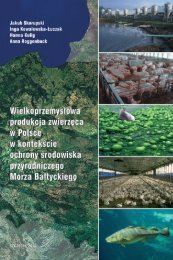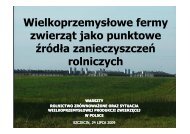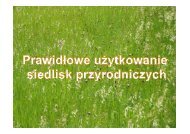best available technologies for manure treatment - Baltic Green Belt
best available technologies for manure treatment - Baltic Green Belt
best available technologies for manure treatment - Baltic Green Belt
Create successful ePaper yourself
Turn your PDF publications into a flip-book with our unique Google optimized e-Paper software.
Best Available Technologies <strong>for</strong> <strong>manure</strong> <strong>treatment</strong> baltic sea 2020<br />
1: INTRODUCTION AND BACKGROUND DESCRIPTION<br />
# Animal type<br />
Kg plant nutrients in the<br />
livestock <strong>manure</strong><br />
N<br />
P<br />
1<br />
1 sow in one year, with a production of 26 piglets till 7.3 kg, contribution<br />
from mating and farrowing stable, fully slotted floors<br />
15,6 4<br />
2 Same as above, contribution from farrowing stable 6,3 1,7<br />
3 10 piglets produced, 7.3 to 32 kg, fully slotted floors 4,5 1,4<br />
4<br />
Total <strong>for</strong> a sow in one year with production of 26 piglets of 32 kg (1 + 2 +<br />
2.6 x 3)<br />
33,6 9,3<br />
5 10 production pigs produced, 32 to 107 kg, drained floor + slots (33/67) 26,4 5,3<br />
6 Total <strong>for</strong> a pig production, per 1 sows and 26 pigs produced (4 + 2.6 x 5) 102,2 23,1<br />
Table 3: Examples of content of N and P in pig slurry (Ministeriet <strong>for</strong> Fødevarer, Landbrug og Fiskeri, 2008).<br />
The <strong>Baltic</strong> Sea area covers 2.3 million square kilometres,<br />
with a population of 90 million. The land use<br />
of the area is unique, with 50% af<strong>for</strong>ested and 20%<br />
arable land. Approximately 30% of the <strong>Baltic</strong> population<br />
lives in the countryside. The <strong>Baltic</strong> Sea covers an<br />
area of around one fourth of the total catchment area.<br />
Table 2 shows a calculation of the load of N and<br />
P in livestock <strong>manure</strong> in all the target countries.<br />
It is by comparison of Table 1 and Table 2 seen,<br />
that the average level of N and P in the produced<br />
livestock <strong>manure</strong> is far below the needs of the crops,<br />
as defined by the Danish fertiliser norms in Table 1<br />
(economic optimal norms, politically reduced with<br />
10% in case of N) as well indicated by the Nitrates<br />
Directive, setting a limit of 170 kg N in livestock<br />
<strong>manure</strong> per ha. The highest production of plant nutrients<br />
in livestock <strong>manure</strong>, i.e. the livestock density,<br />
is seen in the Danish part of the <strong>Baltic</strong> Sea catchment<br />
area, followed by Sweden.<br />
It is on basis of data in Table 1 and Table 2<br />
concerning fertiliser norms (norms have a certain<br />
correlation to the removal by the crops) and the livestock<br />
density in the target countries, suggested that<br />
the minimising of P leaching from livestock <strong>manure</strong><br />
first of all is ensured via distribution on a sufficiently<br />
large agricultural area. There is in the BSR<br />
averagely 37 kg N and 9 kg P per ha in the produced<br />
livestock <strong>manure</strong> (Table 2) – it would in relation to<br />
the Nitrates Directive be possible to expand the livestock<br />
production (170 kg N/ha / 37 kg N/ha =) 4,6<br />
times, and in relation to the need of P as nutrient <strong>for</strong><br />
typical crop rotations (Table 1) be possible to expand<br />
the livestock production (25 kg P/ha / 9 kg P/ha = )<br />
2,8 times 3 .<br />
By comparing Table 1 and Table 3 is seen, that P<br />
typically would be the most limiting factor in a balanced<br />
fertilising with livestock <strong>manure</strong> according the<br />
needs of the crops - see Table 4. It is seen, that the<br />
3 25 kg P/ha is recommended by HELCOM as fertilising norm.<br />
14








